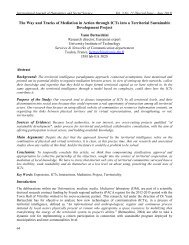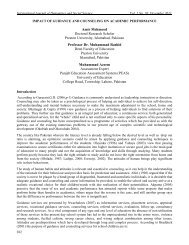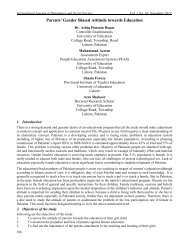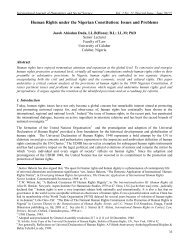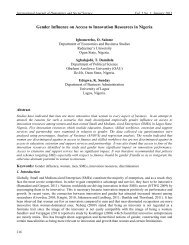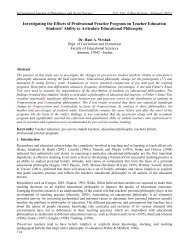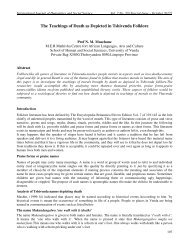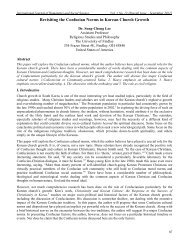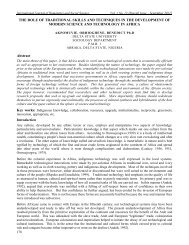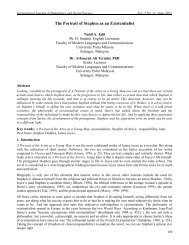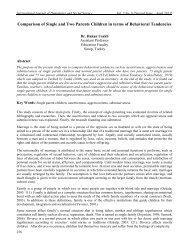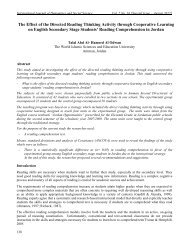Role of Talent Management on Organızatıon Performance in ...
Role of Talent Management on Organızatıon Performance in ...
Role of Talent Management on Organızatıon Performance in ...
Create successful ePaper yourself
Turn your PDF publications into a flip-book with our unique Google optimized e-Paper software.
Internati<strong>on</strong>al Journal <str<strong>on</strong>g>of</str<strong>on</strong>g> Humanities and Social Science Vol. 3 No. 21 [Special Issue – December 2013]<br />
<str<strong>on</strong>g>Role</str<strong>on</strong>g> <str<strong>on</strong>g>of</str<strong>on</strong>g> <str<strong>on</strong>g>Talent</str<strong>on</strong>g> <str<strong>on</strong>g>Management</str<strong>on</strong>g> <strong>on</strong> Organızatı<strong>on</strong> <strong>Performance</strong> <strong>in</strong> Companıes Lısted <strong>in</strong><br />
Naıbobı Securıty Exchange <strong>in</strong> Kenya: Lıterature Revıew<br />
Rita Kagwiria lyria<br />
Department <str<strong>on</strong>g>of</str<strong>on</strong>g> Entrepreneurship and Procurement<br />
Jomo Kenyatta University <str<strong>on</strong>g>of</str<strong>on</strong>g> Science and Technology<br />
P.0 Box 6200-0200’Nairobi Kenya<br />
Abstract<br />
<str<strong>on</strong>g>Talent</str<strong>on</strong>g> management <strong>in</strong>volves positi<strong>on</strong><strong>in</strong>g the right people <strong>in</strong> the right jobs .This ensures that the employees<br />
maximize their talent for optimal success <str<strong>on</strong>g>of</str<strong>on</strong>g> the organizati<strong>on</strong>. As talent management is a relatively new area for<br />
both public and private sector organizati<strong>on</strong>s, most organizati<strong>on</strong>s have prioritized it to ensure they acquire,<br />
develop and reta<strong>in</strong> the right staff. This study aims to review literature related to the role <str<strong>on</strong>g>of</str<strong>on</strong>g> talent management <strong>on</strong><br />
organizati<strong>on</strong> performance with the view to establish gaps for further studies <strong>on</strong> the topic.<br />
Key Words: <str<strong>on</strong>g>Role</str<strong>on</strong>g>, talent management, organizati<strong>on</strong> performance, listed companies ,Nairobi Security Exchange<br />
1. Introducti<strong>on</strong><br />
Nowadays, land, capital and fixed assets are no l<strong>on</strong>ger key resources for the organizati<strong>on</strong>s to be highly<br />
competitive <strong>in</strong> the current ec<strong>on</strong>omy (Gardner, 2002). Human capital is a key resource to adapt the organizati<strong>on</strong>s to<br />
the worldwide competiti<strong>on</strong>. Therefore, organizati<strong>on</strong>s are compet<strong>in</strong>g aga<strong>in</strong>st each other to acquire and reta<strong>in</strong> talents<br />
<strong>in</strong> order to ma<strong>in</strong>ta<strong>in</strong> their operati<strong>on</strong>s and c<strong>on</strong>t<strong>in</strong>ue to grow (Gardner, 2002). In order to <strong>in</strong>crease the effectiveness<br />
<str<strong>on</strong>g>of</str<strong>on</strong>g> a firm several resources can be used to achieve this, which <strong>in</strong>cludes m<strong>on</strong>ey, men and mach<strong>in</strong>es, <str<strong>on</strong>g>of</str<strong>on</strong>g> this<br />
resources the most important <str<strong>on</strong>g>of</str<strong>on</strong>g> them all is the people (Keh<strong>in</strong>de, 2012)<br />
Determ<strong>in</strong>ants <str<strong>on</strong>g>of</str<strong>on</strong>g> talent management <strong>in</strong>cludes; talent attracti<strong>on</strong>, talent retenti<strong>on</strong>, learn<strong>in</strong>g and development and<br />
career management, each <str<strong>on</strong>g>of</str<strong>on</strong>g> these processes must be designed to fit the strategic requirements <str<strong>on</strong>g>of</str<strong>on</strong>g> the bus<strong>in</strong>ess as<br />
well as <strong>in</strong>tegrate with each other .To be successful the talent strategy must be aligned with the organizati<strong>on</strong>s<br />
bus<strong>in</strong>ess strategy .Align<strong>in</strong>g talent strategy with bus<strong>in</strong>ess strategy is usually unmet need <strong>in</strong> many organizati<strong>on</strong>s<br />
(He<strong>in</strong>en et al, 2004).<br />
1.1. <str<strong>on</strong>g>Talent</str<strong>on</strong>g> <str<strong>on</strong>g>Management</str<strong>on</strong>g> from a Global Perspective<br />
Manag<strong>in</strong>g talent is a challenge to all organizati<strong>on</strong>s <strong>in</strong> the c<strong>on</strong>text <str<strong>on</strong>g>of</str<strong>on</strong>g> globalizati<strong>on</strong> irrespective <str<strong>on</strong>g>of</str<strong>on</strong>g> the country<br />
(Gardner, 2002). Moreover, the c<strong>on</strong>cern about the scarcity <str<strong>on</strong>g>of</str<strong>on</strong>g> talent is almost universal. Organizati<strong>on</strong>s around the<br />
world are compet<strong>in</strong>g for the same pool <str<strong>on</strong>g>of</str<strong>on</strong>g> talents. This is seen as a global labor market for talents. Trend <str<strong>on</strong>g>of</str<strong>on</strong>g> global<br />
<strong>in</strong>tegrati<strong>on</strong> shows organizati<strong>on</strong>s’ standardizati<strong>on</strong>s <strong>in</strong> talent recruitment, development and management, to ensure<br />
their competitive positi<strong>on</strong> and c<strong>on</strong>sistency. Therefore organizati<strong>on</strong>s have to adapt global best practices <str<strong>on</strong>g>of</str<strong>on</strong>g> <str<strong>on</strong>g>Talent</str<strong>on</strong>g><br />
management and at the same time adapt the local requirements and local labor market (Stahl et al., 2007). The<br />
organizati<strong>on</strong>s that are very successful worldwide tend to ma<strong>in</strong>ta<strong>in</strong> local recruitment strategies, but they comb<strong>in</strong>e<br />
this local strategy with a more global transfer <str<strong>on</strong>g>of</str<strong>on</strong>g> <strong>in</strong>formati<strong>on</strong> and best practices (Brewsteret al 2007).<br />
2. Literature Review<br />
2.1 <str<strong>on</strong>g>Talent</str<strong>on</strong>g> Attracti<strong>on</strong><br />
The comp<strong>on</strong>ents <str<strong>on</strong>g>of</str<strong>on</strong>g> talent attracti<strong>on</strong> are recruitment and selecti<strong>on</strong>, employer brand<strong>in</strong>g, employee value propositi<strong>on</strong><br />
and employer <str<strong>on</strong>g>of</str<strong>on</strong>g> choice (Armstr<strong>on</strong>g, 2006). Recruitment and selecti<strong>on</strong> requires that organizati<strong>on</strong>s use various<br />
methods or techniques <str<strong>on</strong>g>of</str<strong>on</strong>g> select<strong>in</strong>g the right talent that reflects the culture and value <str<strong>on</strong>g>of</str<strong>on</strong>g> that particular organizati<strong>on</strong><br />
(Armstr<strong>on</strong>g, 2006).The recruitment <str<strong>on</strong>g>of</str<strong>on</strong>g> members <str<strong>on</strong>g>of</str<strong>on</strong>g> talent pool is the first task <str<strong>on</strong>g>of</str<strong>on</strong>g> talent management strategy.<br />
285
The Special Issue <strong>on</strong> Social Science Research © Center for Promot<strong>in</strong>g Ideas, USA www.ijhssnet.com<br />
The talent pool is a group <str<strong>on</strong>g>of</str<strong>on</strong>g> employees with special traits and are source <str<strong>on</strong>g>of</str<strong>on</strong>g> future senior executives(Ballesteros et<br />
al ,2010).The sources <str<strong>on</strong>g>of</str<strong>on</strong>g> talented employees can be <strong>in</strong>ternal or external .The best way to create a talent pool is the<br />
<strong>in</strong>ternal sources s<strong>in</strong>ce the employees have already the knowledge <str<strong>on</strong>g>of</str<strong>on</strong>g> how bus<strong>in</strong>ess processes work and can be<br />
<strong>in</strong>corporated directly <strong>in</strong>to the new positi<strong>on</strong> and the morale <str<strong>on</strong>g>of</str<strong>on</strong>g> workforce uplifted (David et al 2007).However, if<br />
the organizati<strong>on</strong> want to <strong>in</strong>troduce radical changes or to renew the culture ,external sources are the best<br />
(Ballesteros et al ,2010). Employer brand<strong>in</strong>g <strong>in</strong>cludes development <str<strong>on</strong>g>of</str<strong>on</strong>g> an organizati<strong>on</strong>’s image, good enough to<br />
attract employees. In order to attract the best, organizati<strong>on</strong>al brand<strong>in</strong>g is a useful strategy, the organizati<strong>on</strong>s that<br />
manages its corporate brands effectively, ga<strong>in</strong>s advantage <strong>in</strong> the highly competitive global market place .Without<br />
the good brand image, it is difficult to attract the right talents (Ana, 2009).Top rated companies have <strong>on</strong>e<br />
characteristic <strong>in</strong> comm<strong>on</strong> ,that is they give clear and c<strong>on</strong>sistent messages about themselves and that translates <strong>in</strong>to<br />
a str<strong>on</strong>g pull <strong>on</strong> talents (Tanuja, 2007). Employee value propositi<strong>on</strong> is characterized by the potential employee’s<br />
percepti<strong>on</strong> <str<strong>on</strong>g>of</str<strong>on</strong>g> the value <str<strong>on</strong>g>of</str<strong>on</strong>g> an organizati<strong>on</strong> seek<strong>in</strong>g to recruit him. The employee measure value propositi<strong>on</strong> based<br />
<strong>on</strong> the challenge the job posses, work envir<strong>on</strong>ment, tra<strong>in</strong><strong>in</strong>g opportunities, flexibility and reputati<strong>on</strong> <str<strong>on</strong>g>of</str<strong>on</strong>g> the<br />
organizati<strong>on</strong> (Oehley, 2007).<br />
2.2 <str<strong>on</strong>g>Talent</str<strong>on</strong>g> Retenti<strong>on</strong><br />
<str<strong>on</strong>g>Talent</str<strong>on</strong>g> retenti<strong>on</strong> aims to take measures to encourage employees to rema<strong>in</strong> <strong>in</strong> the organizati<strong>on</strong> for the maximum<br />
period <str<strong>on</strong>g>of</str<strong>on</strong>g> time. <str<strong>on</strong>g>Talent</str<strong>on</strong>g> turnover is harmful to a company's productivity because costs <str<strong>on</strong>g>of</str<strong>on</strong>g> attracti<strong>on</strong> are high. Direct<br />
cost refers to turnover costs, replacement costs and transiti<strong>on</strong>s costs, and <strong>in</strong>direct costs relate to the loss <str<strong>on</strong>g>of</str<strong>on</strong>g><br />
producti<strong>on</strong>, reduced performance levels, unnecessary overtime and low morale ( Echols, 2007) .Vaiman et al<br />
(2008) def<strong>in</strong>e two classificati<strong>on</strong>s <str<strong>on</strong>g>of</str<strong>on</strong>g> retenti<strong>on</strong> tool to suffice employee’s expectati<strong>on</strong>: extr<strong>in</strong>sic and <strong>in</strong>tr<strong>in</strong>sic<br />
<strong>in</strong>centives. Extr<strong>in</strong>sic <strong>in</strong>centives <strong>in</strong>cludes different sorts <str<strong>on</strong>g>of</str<strong>on</strong>g> m<strong>on</strong>etary rewards which can satisfy employees‘<br />
physiological needs, while <strong>in</strong>tr<strong>in</strong>sic <strong>in</strong>centives refer to n<strong>on</strong>-m<strong>on</strong>etary rewards that can fulfil employees‘<br />
psychological needs. The m<strong>on</strong>etary reward is admitted as an essential tool to reta<strong>in</strong><strong>in</strong>g talent (Vaiman et al, 2008).<br />
Mendez et al, (2011) further emphasizes that a company needs to <strong>in</strong>vest <strong>in</strong> employee retenti<strong>on</strong> <strong>in</strong> order to be<br />
successful. For example, a good compensati<strong>on</strong> package is important <strong>in</strong> reta<strong>in</strong><strong>in</strong>g employees, <str<strong>on</strong>g>of</str<strong>on</strong>g>fer<strong>in</strong>g an attractive,<br />
competitive benefits package with comp<strong>on</strong>ents such as life <strong>in</strong>surance, disability <strong>in</strong>surance and flexible hours<br />
motivates employees to commit themselves to an organizati<strong>on</strong> (Lockwood et al, 2006). In light <str<strong>on</strong>g>of</str<strong>on</strong>g> the above, a<br />
salary <str<strong>on</strong>g>of</str<strong>on</strong>g>fered to an employee should not <strong>on</strong>ly be viewed as a sum <str<strong>on</strong>g>of</str<strong>on</strong>g> m<strong>on</strong>ey, but as a package <str<strong>on</strong>g>of</str<strong>on</strong>g> remunerati<strong>on</strong> <strong>in</strong><br />
order for the payment to serve as a retenti<strong>on</strong> factor. Gomez-Mejia et al (2006) refers to this as <strong>in</strong>ternal and<br />
external equity. External equity is the perceived fairness <str<strong>on</strong>g>of</str<strong>on</strong>g> the remunerati<strong>on</strong> <strong>in</strong> comparis<strong>on</strong> to how much other<br />
employees <strong>in</strong> the same k<strong>in</strong>d <str<strong>on</strong>g>of</str<strong>on</strong>g> work are receiv<strong>in</strong>g <strong>in</strong> the same <strong>in</strong>dustry. On the other hand, <strong>in</strong>ternal equity refers<br />
to how an employee perceives his pay to be fair <strong>in</strong> comparis<strong>on</strong> to another employee who he perceives to be <strong>in</strong> a<br />
similar positi<strong>on</strong> with<strong>in</strong> the same organizati<strong>on</strong>.<br />
2.3 Learn<strong>in</strong>g and Development<br />
<str<strong>on</strong>g>Talent</str<strong>on</strong>g> development is the process <str<strong>on</strong>g>of</str<strong>on</strong>g> chang<strong>in</strong>g an organizati<strong>on</strong>, its employees, its stakeholders, and groups <str<strong>on</strong>g>of</str<strong>on</strong>g><br />
people with<strong>in</strong> it, us<strong>in</strong>g planned and unplanned learn<strong>in</strong>g, <strong>in</strong> order to achieve and ma<strong>in</strong>ta<strong>in</strong> a competitive advantage<br />
for the organizati<strong>on</strong> (Davis et al, 2007). As bus<strong>in</strong>esses c<strong>on</strong>t<strong>in</strong>ually apply new technologies, new bus<strong>in</strong>ess growth<br />
models, and new market strategies, the workforce‘s up-skill<strong>in</strong>g becomes c<strong>on</strong>stant and c<strong>on</strong>t<strong>in</strong>uous. Understand<strong>in</strong>g<br />
strategies to talent retenti<strong>on</strong> and development will be able to help companies listed <strong>in</strong> the Nairobi Security<br />
Exchange to be successful <strong>in</strong> operat<strong>in</strong>g <strong>in</strong> the market place hence lead to good organizati<strong>on</strong> performance.<br />
Organizati<strong>on</strong>s which practice effective learn<strong>in</strong>g and development beg<strong>in</strong> with their employees. This implies that<br />
they identify the employees who need learn<strong>in</strong>g and development, the level <str<strong>on</strong>g>of</str<strong>on</strong>g> learn<strong>in</strong>g and development they need<br />
and the durati<strong>on</strong> dur<strong>in</strong>g which learn<strong>in</strong>g takes place (Harburg, 2003).organizati<strong>on</strong>s with first class learn<strong>in</strong>g and<br />
development <strong>in</strong>itiatives are excellent <strong>in</strong> listen<strong>in</strong>g <strong>on</strong> employee improvement needs and are able to express those<br />
needs back to the employee <strong>in</strong> clear and enlighten<strong>in</strong>g terms.<br />
CIPD (2010) study <strong>on</strong> learn<strong>in</strong>g and talent development results <strong>in</strong>dicated that <strong>in</strong>-house development programmes<br />
at 56%and coach<strong>in</strong>g by l<strong>in</strong>e managers at 51% ranked am<strong>on</strong>g the top effective learn<strong>in</strong>g and development practices.<br />
E-learn<strong>in</strong>g was also identified as key <strong>in</strong> learn<strong>in</strong>g and development. Moreover, the study found that senior<br />
managers and the human resource department were tasked with ensur<strong>in</strong>g that courses were delivered and overall<br />
plann<strong>in</strong>g <str<strong>on</strong>g>of</str<strong>on</strong>g> the learn<strong>in</strong>g process carried out effectively. This study was carried out through a survey <str<strong>on</strong>g>of</str<strong>on</strong>g> various<br />
organizati<strong>on</strong>s.<br />
286
Internati<strong>on</strong>al Journal <str<strong>on</strong>g>of</str<strong>on</strong>g> Humanities and Social Science Vol. 3 No. 21 [Special Issue – December 2013]<br />
The study also found that the skills the employer said they needed to focus <strong>on</strong> <strong>in</strong> order to meet their bus<strong>in</strong>ess<br />
objectives were ma<strong>in</strong>ly leadership skills at 65%, fr<strong>on</strong>tl<strong>in</strong>e people management skills at 55% and bus<strong>in</strong>ess<br />
awareness at 51%. Learn<strong>in</strong>g and development has become an important talent management <strong>in</strong>itiative <strong>in</strong> many<br />
companies around the world. For some companies, learn<strong>in</strong>g and development is a strategic process that m<strong>in</strong>imizes<br />
leadership gaps for critical positi<strong>on</strong>s and provides opportunities for top talent to develop the skills necessary for<br />
future roles. With other companies, learn<strong>in</strong>g and development is a c<strong>on</strong>stant struggle, viewed as an adm<strong>in</strong>istrative<br />
exercise rather than as a competitive advantage. In str<strong>on</strong>g ec<strong>on</strong>omic times, it is easier to ignore deficiencies <strong>in</strong> the<br />
career management process, but <strong>in</strong> the current ec<strong>on</strong>omic downturn around the world, the need to identify and<br />
develop top talent for critical roles has never been more important (Davis et al,2007).Learn<strong>in</strong>g and development is<br />
an approach <str<strong>on</strong>g>of</str<strong>on</strong>g> an organizati<strong>on</strong> ensur<strong>in</strong>g that people with the right qualificati<strong>on</strong>s and experience are available<br />
when needed (Zheng et al, 2001).<br />
2.4 Career <str<strong>on</strong>g>Management</str<strong>on</strong>g><br />
There are several elements <str<strong>on</strong>g>of</str<strong>on</strong>g> career management <strong>in</strong>clud<strong>in</strong>g career development and plann<strong>in</strong>g which focuses <strong>on</strong><br />
plann<strong>in</strong>g <str<strong>on</strong>g>of</str<strong>on</strong>g> employee growth and progressi<strong>on</strong>; career path<strong>in</strong>g which <strong>in</strong>volves creat<strong>in</strong>g established career paths<br />
and families <str<strong>on</strong>g>of</str<strong>on</strong>g> jobs with<strong>in</strong> a given area allow<strong>in</strong>g employees have a visi<strong>on</strong> <str<strong>on</strong>g>of</str<strong>on</strong>g> progressi<strong>on</strong> as well as goals and<br />
expectati<strong>on</strong>s; employee development c<strong>on</strong>sist<strong>in</strong>g <str<strong>on</strong>g>of</str<strong>on</strong>g> programs and <strong>in</strong>itiatives; learn<strong>in</strong>g and development <strong>in</strong>itiatives;<br />
management coach<strong>in</strong>g; competitive reward systems; career centres; successi<strong>on</strong> plann<strong>in</strong>g; performance<br />
management/feedback; and cross-functi<strong>on</strong>al development programs (Allen ,2005).Career management c<strong>on</strong>sists <str<strong>on</strong>g>of</str<strong>on</strong>g><br />
both formal and <strong>in</strong>formal activities <strong>in</strong>clud<strong>in</strong>g employee workshops, job rotati<strong>on</strong>, job enrichment and career<br />
progressi<strong>on</strong> ladders, for example organizati<strong>on</strong>ally planned programs or developmental stage theories.<br />
Organizati<strong>on</strong>s may also c<strong>on</strong>tribute to career identity by provid<strong>in</strong>g abundant opportunities for self-development,<br />
opportunities for advancement and mentors (Dargham, 2013).<br />
Sturges et al, (2002) observed that organizati<strong>on</strong>al career management enhances employee commitment and hence<br />
organizati<strong>on</strong> performance . Career management help can be seen as <strong>on</strong>e form <str<strong>on</strong>g>of</str<strong>on</strong>g> perceived organizati<strong>on</strong>al support.<br />
Perceived organizati<strong>on</strong>al support has been positively related to job performance and negatively l<strong>in</strong>ked to<br />
withdrawal behaviours such as absenteeism and turnover (Rhoades et al, 2002). Van Dam (2004) found that<br />
people who experience more organizati<strong>on</strong>al support have a higher employability orientati<strong>on</strong>. Kraimer et al. (2003)<br />
studied the relati<strong>on</strong>ship between organizati<strong>on</strong>al career management and perceived career support. They def<strong>in</strong>ed<br />
perceived career support as the employee’s belief that the organizati<strong>on</strong> cares about his or her career needs and<br />
goals. They found that promoti<strong>on</strong>al opportunities and <strong>in</strong>formal organizati<strong>on</strong>al career management activities,<br />
namely <strong>in</strong>formal career discussi<strong>on</strong>s with a manager, participati<strong>on</strong> <strong>in</strong> challeng<strong>in</strong>g job assignments and mentor<strong>in</strong>g<br />
relati<strong>on</strong>ship(s) with senior colleagues, are positively related to perceived career support. Organizati<strong>on</strong>al career<br />
management practices <strong>in</strong>cludes ;performance appraisal as a basis <str<strong>on</strong>g>of</str<strong>on</strong>g> career plann<strong>in</strong>g ,assessment centres, career<br />
counsell<strong>in</strong>g by the human resource department ,formal mentor<strong>in</strong>g ,career workshops, retirement preparati<strong>on</strong><br />
programmes ,successi<strong>on</strong> plann<strong>in</strong>g, formal educati<strong>on</strong> as a part <str<strong>on</strong>g>of</str<strong>on</strong>g> career development and lateral moves to create<br />
cross functi<strong>on</strong>al experience (Agarwala ,2007) .<br />
2.5 <str<strong>on</strong>g>Talent</str<strong>on</strong>g> <str<strong>on</strong>g>Management</str<strong>on</strong>g> and Organizati<strong>on</strong> <strong>Performance</strong><br />
<str<strong>on</strong>g>Talent</str<strong>on</strong>g>-management practices can create the most permanent competitive advantages, new technologies and<br />
<strong>in</strong>novati<strong>on</strong>s can be easily be replicated by competitors and generate <strong>on</strong>ly temporary competitive advantages.<br />
Susta<strong>in</strong>ed competitive advantage comes from talent management practices <strong>in</strong> other words, how the organizati<strong>on</strong><br />
attracts, develops, reta<strong>in</strong>s, motivates, manages, and rewards its talent. (Heimen et al, 2004) Like a mach<strong>in</strong>e, a<br />
bus<strong>in</strong>ess will fail to operate successfully if key elements such as processes, systems, and structure are misaligned<br />
or h<strong>in</strong>dered by fricti<strong>on</strong> between those element and like a mach<strong>in</strong>e, a bus<strong>in</strong>ess must be designed, operated, and<br />
ma<strong>in</strong>ta<strong>in</strong>ed. These functi<strong>on</strong>s are performed by the talent – the human capital employed by the enterprise. Indeed,<br />
talent (i.e., an organizati<strong>on</strong>’s employees), typically is the s<strong>in</strong>gle biggest lever for driv<strong>in</strong>g improvements <strong>in</strong><br />
bus<strong>in</strong>ess performance. The collective skills <str<strong>on</strong>g>of</str<strong>on</strong>g> the talent employed <strong>in</strong> an organizati<strong>on</strong> largely comprise the<br />
organizati<strong>on</strong>’s core capabilities. An organizati<strong>on</strong>’s talent <strong>in</strong>jects capabilities that are very difficult for competitors<br />
to benchmark and replicate. More than any other asset, talent provides the potential for l<strong>on</strong>g-term competitive<br />
advantage (Lawler, 2008).<br />
287
The Special Issue <strong>on</strong> Social Science Research © Center for Promot<strong>in</strong>g Ideas, USA www.ijhssnet.com<br />
73% 0f Executives <strong>in</strong> USA agrees <strong>on</strong> the positive relati<strong>on</strong>ship between talent management and bus<strong>in</strong>ess strategy<br />
to obta<strong>in</strong> the success <str<strong>on</strong>g>of</str<strong>on</strong>g> the organizati<strong>on</strong>s (Ballesteros et al, 2010).It means that companies recognize the<br />
importance <str<strong>on</strong>g>of</str<strong>on</strong>g> talent management <strong>in</strong>tegrati<strong>on</strong> with bus<strong>in</strong>ess strategy to get organizati<strong>on</strong> excellence .<str<strong>on</strong>g>Talent</str<strong>on</strong>g><br />
management is important when the firms would like to build w<strong>in</strong>n<strong>in</strong>g teams which will be formed by talented<br />
people (Davis et al,2007).They can use this teams to solve problems or weaknesses <strong>in</strong> their organizati<strong>on</strong> because<br />
they have competent and experienced people <strong>in</strong> this fields. If a firm wants to be successful, it must <strong>in</strong>vest <strong>in</strong> talent<br />
management <str<strong>on</strong>g>of</str<strong>on</strong>g> their workers to obta<strong>in</strong> some c<strong>on</strong>diti<strong>on</strong>s <strong>in</strong> the company like good bus<strong>in</strong>ess envir<strong>on</strong>ment (Snell,<br />
2005)<br />
3.1C<strong>on</strong>ceptual Framework<br />
<str<strong>on</strong>g>Talent</str<strong>on</strong>g> attracti<strong>on</strong><br />
Brand<strong>in</strong>g<br />
Recruit<strong>in</strong>g and selecti<strong>on</strong><br />
<str<strong>on</strong>g>Talent</str<strong>on</strong>g><br />
<str<strong>on</strong>g>Management</str<strong>on</strong>g><br />
<str<strong>on</strong>g>Talent</str<strong>on</strong>g> retenti<strong>on</strong><br />
Competitive<br />
Compensati<strong>on</strong><br />
Learn<strong>in</strong>g and development<br />
Coach<strong>in</strong>g<br />
Leadership development<br />
Organizati<strong>on</strong> <strong>Performance</strong><br />
Pr<str<strong>on</strong>g>of</str<strong>on</strong>g>it<br />
Growth<br />
Career management<br />
Successi<strong>on</strong> plann<strong>in</strong>g<br />
<strong>Performance</strong> and<br />
feedback management<br />
Independent variables Dependent variable<br />
figure 3.1: c<strong>on</strong>ceptual framework<br />
3.2 <str<strong>on</strong>g>Talent</str<strong>on</strong>g> <str<strong>on</strong>g>Management</str<strong>on</strong>g> Model<br />
Optimis HCM (2011) talent management model identifies various talent management comp<strong>on</strong>ents and l<strong>in</strong>ks them to<br />
workforce performance which eventually leads to organizati<strong>on</strong> performance .See Optimis HCM (2011) model below<br />
288
Internati<strong>on</strong>al Journal <str<strong>on</strong>g>of</str<strong>on</strong>g> Humanities and Social Science Vol. 3 No. 21 [Special Issue – December 2013]<br />
4. C<strong>on</strong>clusi<strong>on</strong><br />
Figure 3.2 <str<strong>on</strong>g>Talent</str<strong>on</strong>g> management Model<br />
Source; optımıs HCM (2011)<br />
From the results <str<strong>on</strong>g>of</str<strong>on</strong>g> the reviewed literature it is observed that most <str<strong>on</strong>g>of</str<strong>on</strong>g> the talent management studies were d<strong>on</strong>e <strong>in</strong><br />
other countries and to the researcher’s knowledge there is limited empirical study d<strong>on</strong>e locally.Also most <str<strong>on</strong>g>of</str<strong>on</strong>g><br />
talent management studies reviewed did not directly l<strong>in</strong>k talent management with the organizati<strong>on</strong> performance<br />
and therefore ,there is a need to fill the exist<strong>in</strong>g research gap by c<strong>on</strong>duct<strong>in</strong>g a study locally to determ<strong>in</strong>e the<br />
role <str<strong>on</strong>g>of</str<strong>on</strong>g> talent management <strong>on</strong> organizati<strong>on</strong> performance <strong>in</strong> companies liseted <strong>in</strong> Nairobi Security Exchange <strong>in</strong><br />
kenya.<br />
289
The Special Issue <strong>on</strong> Social Science Research © Center for Promot<strong>in</strong>g Ideas, USA www.ijhssnet.com<br />
References<br />
Allen, R. (2005). Competitive management practices: ga<strong>in</strong><strong>in</strong>g leverag<strong>in</strong>g <strong>in</strong> the 21 st century. Retrieved 2 nd June 2013<br />
from http://www.ritaballenassociates.com/Career%20Managment .pdf<br />
Ana Harvat (2009) War <str<strong>on</strong>g>of</str<strong>on</strong>g> talent ,Faculty <str<strong>on</strong>g>of</str<strong>on</strong>g> Social sciences and Behavioral sciences .Tilburg University.<br />
Armstr<strong>on</strong>g, M. (2009). Armstr<strong>on</strong>g‘s handbook <str<strong>on</strong>g>of</str<strong>on</strong>g> Human Resources <str<strong>on</strong>g>Management</str<strong>on</strong>g>. Kogan Page, UK.<br />
Boudreau J.W,Ramstad PM (2007)Bey<strong>on</strong>d HR :The new Science <str<strong>on</strong>g>of</str<strong>on</strong>g> Human Capital .Bost<strong>on</strong> ,MA,HavardBus<strong>in</strong>essPress<br />
Brewster, C., Sparrow, P., & Vern<strong>on</strong>, G. (2007). Internati<strong>on</strong>al human resource management.<br />
L<strong>on</strong>d<strong>on</strong>, UK: Chartered Institute <str<strong>on</strong>g>of</str<strong>on</strong>g> Pers<strong>on</strong>nel and Development.<br />
CIPD (2010). Annual survey report: learn<strong>in</strong>g and talent development. Retrieved 25 th May<br />
2013Fromhttp://www.cipd.co.uk/NR/rd<strong>on</strong>lyres/BC060DD1-EEA7-4929-<br />
91421AD733F95E7/5215Learn<strong>in</strong>gtalentdevelopmentsurveyreport.pdf-annual<br />
Dargham, N.A.S. (2013). The organizati<strong>on</strong>al career management and career behavior. Retrieved 3 rd June 2013 from<br />
http://www.fgm.usj.edu.lb/files/a52010.pdf<br />
Davis T<strong>on</strong>y ,Maggie cutt,neil flynn(2007) <str<strong>on</strong>g>Talent</str<strong>on</strong>g> assessment ,a new strategy for talent management .Gower,United<br />
States.Retrived <strong>on</strong> 22 march 2013.<br />
Dyschtwald, K., Ericks<strong>on</strong>, T. & Moris<strong>on</strong>, R. (2006). Workforce crisis: How to beat the com<strong>in</strong>g shortage. Amaz<strong>on</strong>.com<br />
Echols, M. (2007). W<strong>in</strong>n<strong>in</strong>g the turnover war. Retrieved 20 th May 2013 from www.talentmgt. .com<br />
Edward E Lawler .Mak<strong>in</strong>g people your competitive Advatenge University <str<strong>on</strong>g>of</str<strong>on</strong>g> Calif<strong>on</strong>ia,USA<br />
Gara, R. (2007). ‘<str<strong>on</strong>g>Talent</str<strong>on</strong>g> management <strong>in</strong> Egypt.’ Paper prepared for presentati<strong>on</strong> at the Global <str<strong>on</strong>g>Talent</str<strong>on</strong>g> management Centre, July.<br />
Gardner, T.M. (2002). ‘In the trenches at the talent wars: competitive <strong>in</strong>teracti<strong>on</strong> for scarce human resources’, Human<br />
Resources <str<strong>on</strong>g>Management</str<strong>on</strong>g>, Wiley periodicals 41, 225–237<br />
Harburg, F. (2003).The three essential elements <str<strong>on</strong>g>of</str<strong>on</strong>g> learn<strong>in</strong>g and development. Retrieved 2 nd June 2013 from<br />
http://clomedia.com/articles/view/the three essential elements <str<strong>on</strong>g>of</str<strong>on</strong>g> learn<strong>in</strong>g and development<br />
He<strong>in</strong>en Stephen J and Colleen O’neill (2004) manag<strong>in</strong>g <str<strong>on</strong>g>Talent</str<strong>on</strong>g> to maximize performance.Published <strong>on</strong>l<strong>in</strong>e<strong>in</strong> wiley<br />
<strong>in</strong>terscience .www.<strong>in</strong>terscience willey .com.Retrived <strong>on</strong> 15 th October 2013<br />
Gomez-Mejia, L. R., Balk<strong>in</strong>, D. B. & Robert, L. C. (2004). Manag<strong>in</strong>g human resources:, 4th editi<strong>on</strong>, Prentice Hall, USA.<br />
Kah<strong>in</strong>de James Sunday (2012) <str<strong>on</strong>g>Talent</str<strong>on</strong>g> management effect <strong>on</strong> organizati<strong>on</strong> performance .Journal <str<strong>on</strong>g>of</str<strong>on</strong>g> management<br />
research volume 4 No 2<br />
Kraimer, M.L., Seibert, S.E., Wayne, S.J. & Liden, R.C. (2003). ‘Exam<strong>in</strong><strong>in</strong>g employee performance and turnover <strong>in</strong>tenti<strong>on</strong>s<br />
from a career perspective’, Paper presented at the Annual meet<strong>in</strong>g <str<strong>on</strong>g>of</str<strong>on</strong>g> the Academy <str<strong>on</strong>g>of</str<strong>on</strong>g> <str<strong>on</strong>g>Management</str<strong>on</strong>g>, Seattle.<br />
Lockwood, N.R. (2006). ‘<str<strong>on</strong>g>Talent</str<strong>on</strong>g> management: Driver for organizati<strong>on</strong>al success’, research Quarterly, Society for<br />
Human Resource <str<strong>on</strong>g>Management</str<strong>on</strong>g>.<br />
Mendez & Stander (2011). Positive Organizati<strong>on</strong>. ‘The role <str<strong>on</strong>g>of</str<strong>on</strong>g> leader Behaviour <strong>in</strong> work engagement and Retenti<strong>on</strong>’,<br />
South African Journal <str<strong>on</strong>g>of</str<strong>on</strong>g> Industrial Psychology,(37)1.<br />
Oehley, A. (2007). The development and evaluati<strong>on</strong> <str<strong>on</strong>g>of</str<strong>on</strong>g> a partial talent management competency Model. Unpublished<br />
thesis. Stellenbosch. University <str<strong>on</strong>g>of</str<strong>on</strong>g> Stellenbosch.<br />
Optimis (2011) Build<strong>in</strong>g your future –Optimis talent management .hcm.com .retrieved <strong>on</strong> 21 September 2013.<br />
Sara Ballesteros R.and Inmaculada De la Fuente(2010)<str<strong>on</strong>g>Talent</str<strong>on</strong>g>s ;the key for successful Organizati<strong>on</strong>. Unpublished<br />
thesis, L<strong>in</strong>naeus School <str<strong>on</strong>g>of</str<strong>on</strong>g> Bus<strong>in</strong>ess &Ec<strong>on</strong>omics ,L<strong>in</strong>naeus University,<br />
Stahl, K. G., Björkman, I., Farndale, E., Morris, S. S., Paauwe, J., Stiles, P., Trevor, J., & Wright, M. P. (2007). Global<br />
talent management: How lead<strong>in</strong>g mult<strong>in</strong>ati<strong>on</strong>als build and susta<strong>in</strong> their talent pipel<strong>in</strong>e. INSEAD, 34 p.<br />
Snell A. (2007). ‘Strategic talent management, Human Resource <str<strong>on</strong>g>Management</str<strong>on</strong>g>: The relati<strong>on</strong>ship <str<strong>on</strong>g>of</str<strong>on</strong>g> mentor<strong>in</strong>g and<br />
network resources with career success <strong>in</strong> the Ch<strong>in</strong>ese organizati<strong>on</strong>al envir<strong>on</strong>ment’, Int. J. <str<strong>on</strong>g>of</str<strong>on</strong>g> Human Resource<br />
<str<strong>on</strong>g>Management</str<strong>on</strong>g> 17:9 September 1531–1546.<br />
Sturge<strong>in</strong>s, J., Guest, D., C<strong>on</strong>way, N., & Mackenzie D. K. (2002). ‘A l<strong>on</strong>gitud<strong>in</strong>al study <str<strong>on</strong>g>of</str<strong>on</strong>g> the relati<strong>on</strong>ship between<br />
career management and organizati<strong>on</strong>al commitment am<strong>on</strong>g graduates <strong>in</strong> the first years <str<strong>on</strong>g>of</str<strong>on</strong>g> work;journal <str<strong>on</strong>g>of</str<strong>on</strong>g><br />
organizati<strong>on</strong>al behavior ,23,731-748<br />
Tanuja Agarwala (2007) Strategic Human Resource <str<strong>on</strong>g>Management</str<strong>on</strong>g> Faculty <str<strong>on</strong>g>of</str<strong>on</strong>g> management studies, University <str<strong>on</strong>g>of</str<strong>on</strong>g> Delhi,<br />
Oxford University Press<br />
Vaiman V. & Vance C.M. (2008). Smart talent management: build<strong>in</strong>g knowledge assets for competitive advantage.<br />
Edward Elgar Publish<strong>in</strong>g Ltd.<br />
Van Dam, K. (2004). ‘Antecedents and c<strong>on</strong>sequences <str<strong>on</strong>g>of</str<strong>on</strong>g> employability orientati<strong>on</strong>’, European Journal <str<strong>on</strong>g>of</str<strong>on</strong>g> Work and<br />
Organizati<strong>on</strong>al Psychology, 13 (1), 29-52.<br />
Zheng, A. Y. & Kle<strong>in</strong>er, Brian, H. (2001). Developments c<strong>on</strong>cern<strong>in</strong>g career development and transiti<strong>on</strong>’, Journal <str<strong>on</strong>g>of</str<strong>on</strong>g><br />
<str<strong>on</strong>g>Management</str<strong>on</strong>g> Research, Vol: 24 Issue: 3: 33-39<br />
290



